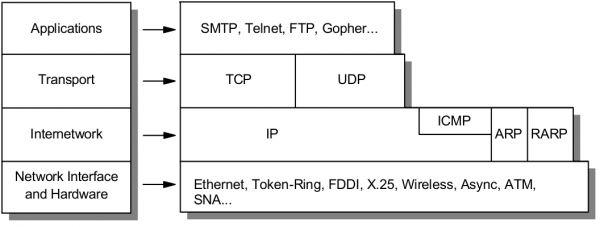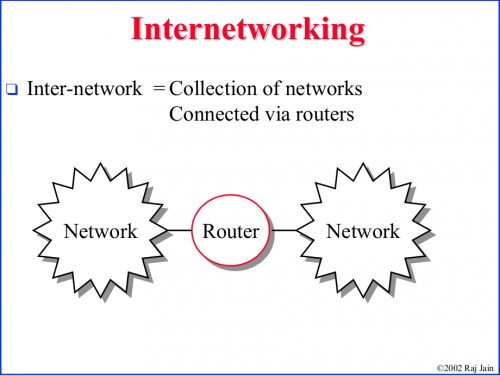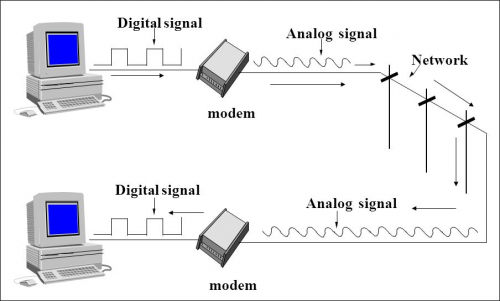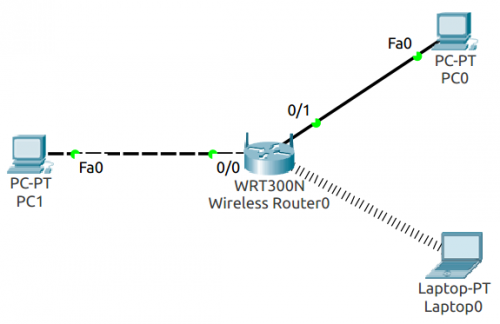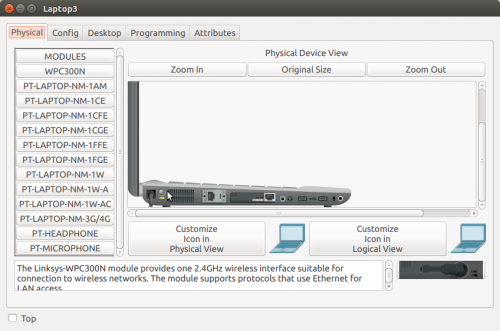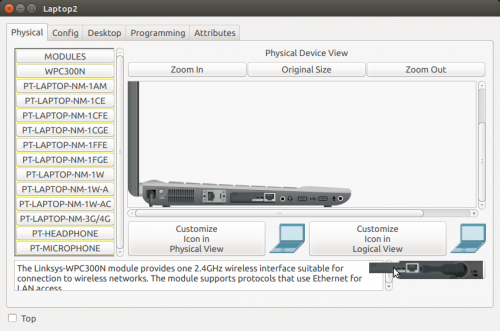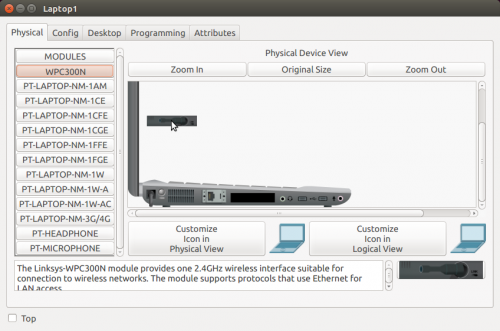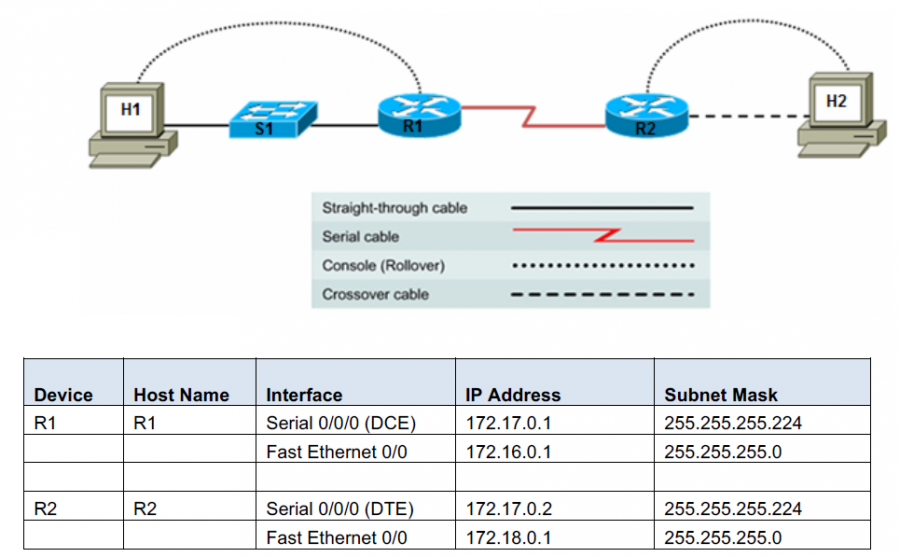Networking
Instalar versión 6.2 de Packettracer
Contents
[hide]- 1 Sistema binario
- [+]2 Terminología
- [+]3 TCP/IP
- [+]4 Introduction to Internetworking and Network equipments
- [+]5 IP addressing
- 6 Configuring basic router settings
- 7 WAN
- [+]8 Routing
- [+]9 Wireless LANs (WLANs)
- 10 Wireless mobile networks
- 11 Para ver las características de las tarjetas de red (network card)
- [+]12 Network simulation using Cisco-PacketTracer
Sistema binario
Conversión de un número en el sistema decimal al binario:
Conversión de Binario a decimal:
Terminología
Protocols
Think of protocols as a standard way of communication between a client and a server.
WAN
A Wide Area Network is a telecommunications network or computer network that extends over a large geographical distance. https://en.wikipedia.org/wiki/Wide_area_network
LAN
A Local Area Network is a computer network that interconnects computers within a limited area such as a residence, school, laboratory, university campus or office building. https://en.wikipedia.org/wiki/Local_area_network
Puertos
- The wireless router’s WAN (Internet) port (el puerto WAN (Internet) del wireless router).
- The wireless router’s LAN (Ethernet) ports.
- RS-232: is a standard for serial communication transmission of data. https://en.wikipedia.org/wiki/RS-232
Elegir el puerto correcto
- Cuando se conecta un cable a una PC en Packet Tracer, el programa propone (por defecto) conectarlo al puerto FastEthernet, USB o RS-232. Hasta ahora hemos estado usando el puerto FastEthernet.
- Cuando se conecta un cable a un Router, PacketTracer propone el puerto Internet o Ethernet. Creo que el puerto Internet se usa cuando estamos conectando el Router con una WAN y el Ethernet es para una LAN.
Cables
- As a rule, between different divices we use a straight cable an between same divices a cross-over cable (Creo que el Prof. confirmó esto, no estoy seguro)
- Crossover cable:
- From a PC to the wireless router’s WAN (Internet) port.
- Straight through cable:
- From PC to one of the wireless router’s LAN (Ethernet) ports.
TCP/IP
https://en.wikipedia.org/wiki/Internet_protocol_suite
The Internet protocol suite is the conceptual model and set of communications protocols used on the Internet and similar computer networks.
The Internet protocol suite provides end-to-end data communication specifying how data should be packetized, addressed, transmitted, routed, and received. This functionality is organized into four abstraction layers which classify all related protocols according to the scope of networking involved. From highest to lowest, the layers are:
- The application layer: it provides process-to-process data exchange for applications. HTTP, FTP, DNS etc.
- The transport layer: handling host-to-host communication. TCP, UDP, etc.
- The internet (Internetwork) layer: providing internetworking between independent networks. IP (IPv4, IPv6), etc.
- Network interface and Hardware [Datalink, Physical] layer: containing communication methods for data that remains within a single network segment (link). Ethernet, Wireless, etc.
Applications
HTTP
The HTTP request. HTTP is the pull protocole. A client pulls a page from the server.
FTP
DNS
Transport
TCP
TCP (Transmision Control Protocol)
Internetwork
IP
Network interface and Hardware [Datalink, Physical]
Ethernet
Wireless
OSI model
https://en.wikipedia.org/wiki/OSI_model#Comparison_with_TCP.2FIP_model
| OSI Model | ||||
|---|---|---|---|---|
| Layer | Protocol data unit (PDU) | Function | ||
| Host layers |
7. Application | Data | High-level APIs, including resource sharing, remote file access | |
| 6. Presentation | Translation of data between a networking service and an application; including character encoding, data compression and encryption/decryption | |||
| 5. Session | Managing communication sessions, i.e. continuous exchange of information in the form of multiple back-and-forth transmissions between two nodes | |||
| 4. Transport | Segment (TCP) / Datagram (UDP) | Reliable transmission of data segments between points on a network, including segmentation, acknowledgement and multiplexing | ||
| Media layers |
3. Network | Packet | Structuring and managing a multi-node network, including addressing, routing and traffic control | |
| 2. Data link | Frame | Reliable transmission of data frames between two nodes connected by a physical layer | ||
| 1. Physical | Bit | Transmission and reception of raw bit streams over a physical medium | ||
Introduction to Internetworking and Network equipments
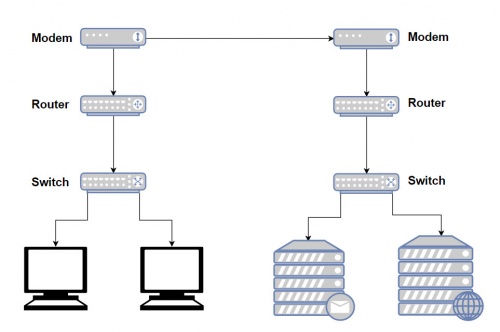
Modem
https://www.webopedia.com/TERM/M/modem.html
http://homepages.uc.edu/~thomam/Net1/Modems%20&%20D-A%20Conversion/modem_main.html
A modem (Short for modulator-demodulator) is a device or program that convert digital information to analog signals (modulation), and to convert analog signals back into useful digital information (demodulation). It enables a computer to transmit data over, for example, telephone or cable lines. http://homepages.uc.edu/~thomam/Net1/Modems%20&%20D-A%20Conversion/modem_main.html
Computer information is stored digitally, whereas information transmitted over telephone lines is transmitted in the form of analog signal. A modem converts between these two forms.
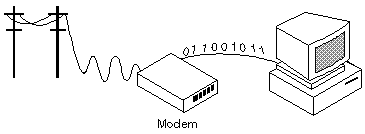
Router
http://www.diffen.com/difference/Router_vs_Switch
Router and switches are both computer networking devices that allow one or more computers to be connected to other computers, networked devices, or to other networks.
The functions of a routers, switch and hub are all different, even if at times they are integrated into a single device.
Routers can connect wired or wireless (WiFi) networks. A switch is used for wired networking connections.
A router is a networking device that connects computer networks (connect two or more logical subnets). For example, connecting a home network with the Internet.
Routers operate at Layer 3 (network layer) of the OSI model. They direct traffic and perform other functions to efficient network operation. For example, they receive TCP/IP packets, look inside each packet to identify the source and target IP addresses, then forward these packets as needed to ensure the data reaches its final destination.
In addition, routers often perform network address translation (NAT), which allows all devices on a subnetwork (e.g., all devices in a home) to share the same public IP address.
Como se mencionó arriba, routers can connect wired or wireless (WiFi) networks.
Existen diferentes tipos de Routers. El uso y la manera de configurarlos varía notablemente:
The largest routers (such as the Cisco CRS-1 or Juniper PTX) interconnect the various ISPs, or may be used in large enterprise networks. Smaller routers usually provide connectivity for typical home and office networks. https://en.wikipedia.org/wiki/Router_(computing)
Al parecer se habla también Wireless Routers. Creo sin embargo que este dispositivo sería un Router equipado con un AP y una tarjeta de red wireless.
En el Lab 1 se realiza un modelado de networks en el cual se emplea un Wireless Router. Este Wireless Router podría, por ejemplo, representar el Router que se encuentra integrado en la Box de nuestra home network. En el Lab 1, note que en este Router las configuraciones se ralizan a través de un GUI.
En el Lab 4: Configuring basic router settings with the Cisco IOS CLI, se presenta un modelado de network en el cual se emplea un Router Cisco. Note que este tipo de Routers son configuring with the Cisco IOS CLI (línea de comandos).
Switch
A network switch is a computer networking device that is used to connect many devices together on a single computer network (within one local area network (LAN)).
Switches are incapable of joining multiple networks or sharing an Internet connection.
A switch is also called switching hub, bridging hub, or MAC bridge. Switches use MAC addresses to forward data to the correct destination. A switch is considered a Layer 2 device, operating at the data link layer; switches use packet switching to receive, process and forward data.
A switch is considered more advanced than a hub because a switch will on send msg to device that needs or request it
Access point
The Access Point (AP) is the central node in 802.11 wireless implementations. It is the interface between wired and wireless network
An access point is a hardware device that receives data by wired Ethernet and, using 2.4GHz or 5GHz radio waves bands, converts to a wireless signal. It sends and receives wireless traffic to and from nearby wireless clients.
For a home environment, most often you have a router, a switch, and an AP «embedded in one box (into a single device)», making it really usable for this purpose.
IP addressing
IP address
Dirección IP
Classful network
Clases de direcciones IP
| Classe | Bits de départ | Début | Fin | Notation CIDR | Masque de sous-réseau par défaut |
|---|---|---|---|---|---|
| Classe A | 0 | 0.0.0.0 | 127.255.255.255 | /8 | 255.0.0.0 |
| Classe B | 10 | 128.0.0.0 | 191.255.255.255 | /16 | 255.255.0.0 |
| Classe C | 110 | 192.0.0.0 | 223.255.255.255 | /24 | 255.255.255.0 |
| Classe D (multicast) | 1110 | 224.0.0.0 | 239.255.255.255 | non défini | |
| Classe E (réservée) | 1111 | 240.0.0.0 | 255.255.255.255 | non défini |
IP Privado
ifconfig
ifconfig
IP Público
curl ipinfo.io/ip
Subnet mask
IP/Subnet Calculator:
- http://jodies.de/ipcalc (Éste me pareció excelente)
- http://www.subnet-calculator.com/ (Éste no me gustó pero tiene una pestaña que permite seleccionar la Subnet Mask. En ella se presentan las Subnets comúnmente usadas.
La subnet mask que generalmente he estado usando para los ejemplos es la 255.255.255.0 (/24). Esta subnet mask indica que los primeros 24 bits de una IP deben ser iguales para pertenecer a la misma subnet. Esta en particular es muy fácil, y se puede ver fácilmente el rango de IP's que define. Por ejemplo:
- Si tenemos: 172.17.0.1/24, podemos fácilmente saber que: ( Ver http://jodies.de/ipcalc )
Address: 172.17.0.1 10101100.00010001.00000000 .00000001
Netmask: 255.255.255.0 = 24 11111111.11111111.11111111 .00000000
Wildcard: 0.0.0.255 00000000.00000000.00000000 .11111111
=>
Network: 172.17.0.0/24 10101100.00010001.00000000 .00000000 (Class B)
Broadcast: 172.17.0.255 10101100.00010001.00000000 .11111111
HostMin: 172.17.0.1 10101100.00010001.00000000 .00000001
HostMax: 172.17.0.254 10101100.00010001.00000000 .11111110
Hosts/Net: 254 (Private Internet)
- Ahora, en el caso de 172.17.0.1/27, las cosas no son tan evidentes:
Address: 172.17.0.1 10101100.00010001.00000000.000 00001
Netmask: 255.255.255.224 = 27 11111111.11111111.11111111.111 00000
Wildcard: 0.0.0.31 00000000.00000000.00000000.000 11111
=>
Network: 172.17.0.0/27 10101100.00010001.00000000.000 00000 (Class B)
Broadcast: 172.17.0.31 10101100.00010001.00000000.000 11111
HostMin: 172.17.0.1 10101100.00010001.00000000.000 00001
HostMax: 172.17.0.30 10101100.00010001.00000000.000 11110
Hosts/Net: 30 (Private Internet)
- 172.17.0.1/30
Address: 172.17.0.1 10101100.00010001.00000000.000000 01
Netmask: 255.255.255.252 = 30 11111111.11111111.11111111.111111 00
Wildcard: 0.0.0.3 00000000.00000000.00000000.000000 11
=>
Network: 172.17.0.0/30 10101100.00010001.00000000.000000 00 (Class B)
Broadcast: 172.17.0.3 10101100.00010001.00000000.000000 11
HostMin: 172.17.0.1 10101100.00010001.00000000.000000 01
HostMax: 172.17.0.2 10101100.00010001.00000000.000000 10
Hosts/Net: 2 (Private Internet)Definición de una subred
A través de la Máscara de subred se define que IPs forman parte del la misma Red (directa)
La notación 192.160.136.4/24 define una máscara de subred en donde los primeros 24 bits son 1 --> 255.255.255.0
Network address
Broadcast address
https://www.techopedia.com/definition/2384/broadcast-address
Gateway
El comando route: http://www.thegeekstuff.com/2012/04/route-examples
route
Internet speed
https://askubuntu.com/questions/104755/how-to-check-internet-speed-via-terminal
La velocidad de la conexión Internet se puede medir en kbit/s (Download/Upload)
Podemos usar el siguiente script en línea:
curl -s https://raw.githubusercontent.com/sivel/speedtest-cli/master/speedtest.py | python -
o instalar el programa usado en la linea de comando anterior (speedtest-cli) como se explica aquí: https://fossbytes.com/test-internet-speed-linux-command-line/
sudo apt-get install speedtest-cli OR
sudo apt-get install python-pip pip install speedtest-cli
To test internet speed, just type the following command and press enter:
speedtest-cli
You can find various options in the help section of the utility:
speedtest-cli -h
Display the internet speed in megabytes/sec:
speedtest-cli --bytes
También podemos obtener una medida a través de wget:
wget -O /dev/null http://speedtest.wdc01.softlayer.com/downloads/test10.zip
Desplegar la ruta de un paquete enviado en Internet
El comando traceroute permite optener la ruta de un paquete enviado.
traceroute google.com
En el ejemplo anterio podemos ver que el paquete pasa por el IP 109.255.255.254 (que debería ser el Gateway de mi ISP). En la página que muestro a continuación se pude ver que dicho IP pertenece a mi ISP y está ubicado en Cork.
Who is my ISP
Este sitio muestra ISP: https://www.whoismyisp.org/
Configuring basic router settings
WAN
Routing
Static routing
Dynamic routing
Administrative Distance (AD)
In some cases, internetworks use Multiple Routing Protocols. In such cases, a router learns of multiple routes to a particular subnet using different routing protocols. Which will be used? AD is used to rank routing protocols. AD is an integer from 0 to 255 that rates the trustworthiness of the source of the IP routing information.
| Route Source | Administrative Distance |
|---|---|
| Connected routes | 0 |
| Static routes | 1 |
| OSPF | 110 |
| IS-IS | 115 |
| RIP (V1 and V2) | 120 |
| Unknown/Unbelievable | 255 |
Wireless LANs (WLANs)
A WLAN is a Wireless Local Area Network, which is the linking of two or more computers without using wires. Instead, radio waves and IEEE 802.11 are used to communicate.
WLANs use infrared light (IR) or radio frequencies (RFs). The use of RF is far more popular for its longer range, higher bandwidth, and wider coverage.
Wireless technologies
- PAN/WPAN (Personal Area Network (PAN)/ Wireless Personal Area Network (WPAN)
- Bluetooth, IEEE 802.15.4
- LAN (Local Area Network)
- IEEE 802.11
WLAN Components
- Wireless Client Receiver: it is needed to connect a computing device (e.g. desktop, laptop, PDA…) to the wired networked via an access point. It includes Onboard Cards (most laptops) PCMCIA, PCI card or USB adaptor
- Access points (APs): they are needed only in the Infrastructure Mode of WLANs. They provide the wireless client with a point of access into a network. They are like Ethernet switches in a wired network and operate in half-duplex mode (e.g. They either receive or transmit at any given time).
The WLAN supports four Network Topologies
- Peer-to-peer (Ad hoc) Topology
- Hybrid Topology
- Infrastructure Topology
- Point-to-point Topology
802.11 standards
- 802.11 is the generic name of a family of standards for wireless networking.
- Popular 802.11 standards include 802.11a, 802.11b, 802.1g, 802.11n, 802.11ac (Newest)
Some EEE 802.11 standards are:
| Standard | Frequency band | Max speed |
|---|---|---|
| 802.11 | 2.4 GHz | 2 Mbps |
| 802.11a | 5 GHz | 54 Mbps |
| 802.11b | 2.4 GHz | 11 Mbps |
| 802.11g | 2.4 GHz | 54 Mbps |
| 802.11n | 2.4 or 5 GHz | 600 Mbps |
| 802.11ac | 5 GHz | 1 Gbps |
Wireless Security
Wireless mobile networks
Para ver las características de las tarjetas de red (network card)
http://www.linuxnix.com/find-network-cardwiredwireless-details-in-linuxunix/
Tales como: Name of network cards, Network card link status, Network card speeds, Network card MAC address, Network card IP address, Network card driver details, Network card manufacture details, Network card duplex/half duplex details, Network card auto-negotiation details, Complete network card capabilities details, Complete network card hardware details
sudo lshw -c network
Network simulation using Cisco-PacketTracer
Cisco - PacketTracer
El paquete (Linux or Windows) se descarga de la página oficial de Cisco (netacad): https://www.netacad.com/group/offerings/packet-tracer
La versión 6.2 puede ser descargada aquí: https://arief-jr.blogspot.ie/2016/01/download-cisco-packet-tracer-62-for.html
Creé una cuenta en Cisco para poder tener acceso a PacketTracer. Contraseña: Aa1640774200
Packet Tracer is a powerful network simulation program which allows students to experiment with network behavior. It supplements physical equipment in the classroom by allowing students to create a network with an almost unlimited number of devices, encouraging practice, discovery and troubleshooting.
Intalación en Ubuntu
sudo ~/Downloads/PacketTracer70/./install
Luego de instalarlo encontré el error descrito y solucionado aquí: https://forum.ubuntu-fr.org/viewtopic.php?id=2014677
J'ai complété l'installation du logiciel puis j'ai essayé de me rendre dans le tableau de bord( dash) pour y trouver le logiciel où il ne se trouvait pas. Par ligne de commande, j'ai essayé de taper : packettracer et cela me dit simplement: "Starting Packet Tracer 7.1" et ne fait plus rien ensuite.
Donc tu ouvres un beau terminal, et tu lances :
/opt/pt/bin/PacketTracer7
Quand j'accède au fichier pour ./PacketTracer7: error while loading shared libraries: libQt5Script.so.5: cannot open shared object file: No such file or directory
Instalar:
libqt5script5
Je viens de le faire mais à l'instant mais ça ne résous pas mon cas,
je suis retourné voir le fichier /opt/pt/bin/PacketTracer7 et quand je l'ouvre, il m'indique qu'il me manque la librairie : " libQt5ScriptTools.so.5" j'ai donc essayé de refaire la même chose que précédemment en l'adaptant à la librairie , donc je tape :
sudo apt-get install libqt5scripttools5
Et maintenant, ça fonctionne quand je vais chercher le fichier /usr/pt/bin/PacketTracer7
Luego para porder launch a través de packettracer in a terminal:
sudo ln -s /opt/pt/bin/PacketTracer7 /usr/local/bin/packettracer
Configuration más frecuentes using PacketTracer
- IP configuration on a PC: Click on the desktop tab, then selecting the IP configuration icon.
- Verify connectivity settings: On a PC, verify the connectivity settings by going to Desktop and clicking on command prompt. At the command prompt, type the command:
- ipconfig : To view your network device information.
- ipconfig /release :
- ipconfig /renew : To force the PC to request an IP address from the Router.
Lab 1: Configuring Wireless Access and Security
In this lab, you will configure a Linksys WRT300N (https://en.wikipedia.org/wiki/Linksys_routers#WRT300N) in Packet Tracer.
Cofigurar la conección entre el Router y la WAN / LAN
Setup the device topology diagram
- Setup the devices as shown in Figure Figure 1:
- PC1 will be acting as the Internet connection
- PC0 and Laptop0 will be in our LAN.
- Connect a crossover cable from PC1 to the wireless router’s WAN (Internet) port and connect a straight through cable from PC0 to one of the wireless router’s LAN (Ethernet) ports.
- Podemos pensar en esta configuración de la siguiente forma: el Wireless Router podría, por ejemplo, representar el Router que se encuentra integrado en la Box de nuestra home network; al cual hemos conectado una PC0 a través de un cable y nuestra Laptop a la Wireless Network. PC1 representa cualquier PC fuera de nuestra LAN.
Configurar la conexión en PC1 y PC0
NOTA: Normalmente deberíamos configurar el Router antes de los dispositivos en la LAN. Esto porque el DHCP Server del Router asignará los IP's a nuestros dispositivos en la LAN; y las confuguraciones en el Router afectarán, por supuesto, las IP's otorgadas a los dispositivos. Sin embargo, a manera de ejercicio, y con el fin de destacar ciertos detalles, vamos primero a realizar las configuraciones en los dispositivos dentro de la LAN.
- PC1 will be acting as the Internet connection, so we need to set the IP address, subnet mask, and default gateway statically as listed in Table 1.
- Set the IP configuration on PC0 to DHCP by clicking on the desktop tab, then selecting the IP configuration icon.
- The wireless router will provide an IP address to the PC0 using the default DHCP configuration.
- Verify connectivity settings for PC0: Go to Desktop and click on command prompt. At the command prompt, type the command ipconfig to view your network device information.
- If the PC does not receive an IP address in the command prompt type ipconfig /renew, this will force the PC to request an IP address from the Router.
- Notice which IP address is the default gateway. This is the default IP address of a Linksys WRT300N. Por tanto, el Router a asignado un IP a PC0 a través de la configuración por defecto (ver Nota al inicio de esta sección).
Configurar el Router
Click on the Wirelessrouter0 and select the Setup tab for the wireless router’s GUI.
Log in
In the real world the default login credentials are a username admin and a password of: admin. Note that this is very insecure since it is the factory default and provided publicly. You will set our own password in a later task.
Configure the WAN interface
Normally an Internet Service Provider would use DHCP to give out addresses to the WAN port. For this lab, you will assign the address statically.
- Configure the WAN port to have a static IP address:
- From the Internet Connection Type pull-down menu, select Static IP and set the IP address settings for Internet Setup:
- Internet IP Address - set to: 172.17.88.35
- Subnet Mask: 255.255.255.0
- Default Gateway - set to the ISP address: 172.17.88.1
- From the Internet Connection Type pull-down menu, select Static IP and set the IP address settings for Internet Setup:
Configure the LAN IP addressing
- Set the Network Setup Address:
- Under Network Setup, enter the Router IP of 172.17.30.1 / Subnet Mask: 255.255.255.0
- NOTE: At this point you would be disconnected from the web page if you were configuring from a PC, as you just changed the IP address you are connected to. It would take a minute or two, and you would need to refresh your browser, but you should be redirected to the new URL of the web utility. If not, you would need to release your IP address and request a new one, before your navigate your browser there. You would be asked to login again.
- Under Network Setup, enter the Router IP of 172.17.30.1 / Subnet Mask: 255.255.255.0
Verify IP address changes:
La configuración de la LAN IP addressing en el Router, afectará, por supuesto, la IP Address que el DHCP Server del Router asígnará a las PC's de la LAN. Para observar dichos cambios vamos al Command prompt de PC0 y ejecutamos: ipconfig /release ipconfig /renew
Luego de esto, note la nueva IP asignada por el DHCP Server del Router.
Verify connectivity
Ping the WAN IP Address of the Wireless Router (172.17.88.35) to verify you can get to the outside of your network. The pings should succeed. If you try to Ping PC1 172.17.88.1, it may fail if your firewall won’t allow replies back in.
Wireless settings
Basic wireless wettings on the Routher
The Linksys WRT300N allows you to choose which network mode to operate in. Currently, the most common network mode for clients is Wireless-G and for routers is BG-Mixed. When a router is operating in BG-Mixed, it can accept both B and G clients. However, if a B client connects, the router must scale down to the slower level of B. For this lab, pick the fastest speed your clients can support.
On WRS1, navigate to the Wireless page:
- Set the Network Name (SSID) to WRS_1
- Wireless-N Only – Radio Band – Change to Standard – 20MHz Channel.
- Standard Channel – Leave at default
- SSID Broadcast – Leave Enabled for now.
Incorporar una Wireless Network Card a la Laptop
Por defecto, Packet Tracer no incorpora una Wireless Network Card (en este caso compatible con Linksys WRT300N) a la Laptop. Debemos entonces incorporar una antes de intentar hacer la Wireless conection.
Si intentamos verificar la conexión en la Laptop antes de incorporar la Wireless Network Card:
- Go to the Desktop tab then select the PC Wireless Icon.
... el programa desplegará el siguiente mensaje: «A WMP300N or WPC300N wireless interface is required to connect»
Para incorporar la Wireless Network Card:
- Click on the Laptop > Physical
- Observar el diseño de la Laptop (observar los diseños de los dispositivos que presenta la Laptop) (Figure 2)
- Note que la Network Card corresponde a un puerto FastEthernet.
- Antes de realizar el cambio, debemos apagar la Laptop. Para esto haga clic en el botón que se encuentra al lado de la conexión electrica. Arriba de la luz verde que simboliza que el dispositivo se encuentra encendido. Note que luego de prescionarlo desaparece la luz verde, lo cual indica que el dispositivo se encuentra apagado. (Figure 2 and Figure 3)
- Utilizando el cursor del mouse, arraste la actual tarjeta de red (FastEthernet) hacia la esquina inferior derecha, hacia el espacio en donde se muestra el diseño de los dispositivos físicos. Note que si se ha arrastrado correctamente, el espacio en donde se encontraba la tajeta de red en la Laptop quedará libre. (Figure 3 and Figure 4)
- Ahora arrastre la tarjeta que desea instalar desde las distintas opciones que se encuentran en el panel a la derecha hacia el espacio libre en la Laptop. (Figure 4)
- En este caso debemos escoger una WPC300N. (Figure 4)
Verify wireless connection
Ahora que hemos incorporado una Wireless network card a nuestra Laptop, podemos entonces verificar la Wireless connection:
- Go to the Desktop tab then select the PC Wireless Icon. Click on the Connect Tab.
- If necessary, you may have to click on Refresh to update your wireless networks. You should see the new network (WRS_1).
- Click on the name to highlight it and then click Connect. Click on the Link Information Tab. When it is done, it will congratulate you on creating a profile (Message: You have successfully connected to the access point).
Configure DHCP Settings
Give a static DHCP binding to PC0 and Laptop0
- On Laptop0, verify connectivity settings going into cmd. At the command prompt, type the command Ipconfig /all to view your network device information. Note the Physical Address (MAC) of the Wireless Connection.
- On the Router, navigate back to the Setup page (the Basic Setup is the default tab). In the middle of the Basic Setup Page, under DHCP Server Settings, click the DHCP Reservations button. Una nueva ventana se abrirá...
- There are two ways to assign DHCP addresses:
- The first method will always assign the client the same address the client has right now.
- Find PC0 by its MAC address in the list of current DHCP clients (Hint: it should be listed as a LAN connection)
- Check the Select box next to your PC. Click Add Clients. Now PC0 will show up under Clients Already Reserved.
- This gives PC0 (in this example, the computer with a MAC address of 00:60:5C:D9:2D:1D) the same IP address it has right now (172.17.30.100) whenever it requests an address through DHCP.
- The first method will always assign the client the same address the client has right now.
- The second method to assign DHCP addresses is to select the address you want the machine to get. You will assign Laptop0 the static IP address listed in the Addressing Table, not the one it received initially.
- Under Manually Adding Client, enter your client’s actual name (puse Laptop0 aquí pero no estoy seguro) , .24 for the IP address, the actual MAC address of your PC’s Wireless Connection, and click Add. Now whenever Laptop0 connects to the wireless router, it receives the IP address 172.17.30.24 via DHCP.
- The second method to assign DHCP addresses is to select the address you want the machine to get. You will assign Laptop0 the static IP address listed in the Addressing Table, not the one it received initially.
Configure other DHCP server settings
Right underneath the DHCP Reservation are the other settings for the DHCP server.
What is the default maximum number of users the WRS300N will hand out DHCP addresses to?
- 50 users.
- Start IP Address - Change to: 172.17.30.50.
- Maximum Number of Users - Change to: 75
These settings give any PC that connects (wired or wirelessly) to this router requesting an IP address through DHCP, an address between 172.17.30.50–124. Only 75 clients at a time are able to get an IP address and they can only have the address for 24 hours, after which time they must request a new one.
Verify the static IP address change and conection
On both PC0 and Laptop0, at the command prompt, type:
Ipconfig /release Ipconfig /renew
... to verify the IP addresses you assigned are used. On Laptop0, ping the IP address of the WAN port to verify you can reach the Internet.
Lab 4: Configuring basic router settings with the Cisco IOS CLI
Cisco IOS (Internetwork Operating System) CLI (IOS Command Line Interface)
In this lab, you will build a multi-router network and configure the routers to communicate using the most common Cisco IOS configuration commands.
""" Resumen de comandos """
Al tratar de configurar un puerto serial en el cual conecté un cable serial DTE:
clock rate 250000
This command applies only to DCE interfaces
enable
#configure terminal
""""""""""""""""""""""""""""""""
(config)#hostname R1
""""""""""""""""""""""""""""""""
(config)#line console 0
(config-line)#password cisco
(config-line)#login
(config-line)#exit
""""""""""""""""""""""""""""""""
(config)#line vty 0 4
(config-line)#password cisco
(config-line)#login
(config-line)#exit
""""""""""""""""""""""""""""""""
(config)#enable password cisco
(config)#enable secret class
""""""""""""""""""""""""""""""""
(config)#banner motd #Unauthorized Use Prohibited#
""""""""""""""""""""""""""""""""
(config)#no ip domain-lookup
""""""""""""""""""""""""""""""""
(config)#line console 0
(config-line)#logging synchronous
""""""""""""""""""""""""""""""""
show ip interface brief
""""""""""""""""""""""""""""""""
(config)#interface serial 0/0/0
(config-if)#description WAN link to R2
(config-if)#ip address 172.17.0.1 255.255.0.0
(config-if)#clock rate 64000
(config-if)#no shutdown
(config-if)#exit
#show interfaces serial 0/0/0
""""""""""""""""""""""""""""""""
(config)#interface FastEthernet 0/0
(config-if)#description R1 LAN Default Gateway
(config-if)#ip address 172.16.0.1 255.255.0.0
(config-if)#no shutdown
(config-if)#exit
#show interfaces FastEthernet 0/0
""""""""""""""""""""""""""""""""
#copy running-config startup-config
""""""""""""""""""""""""""""""""
#show running-config
Configuring basic router settings
Utilizaremos un Router-PT (Generic)
In real life tenemos que conectar un console cable from a computer to the router para poder hacer las configuraciones en el Router. Sin embargo en Packettracer podemos simplemente hacer clic en el routar y acceder al CLI.
- Click on the Router > CLI:
Would you like to enter the initial configuration dialog? No (para así entrar a la línea de comandos desde el inicio, sin que el sistema nos proponga las opciones de configuración automáticamente).
Enter privileged EXEC mode
Router> Router>enable Router#
El comando «enables» is used to enter privileged EXEC mode. Como el Router aún no ha sido configurado, éste no solicita un password luego del comando «enable». Ya veremos como configurar un password. Note que luego de ingresar el comando «enable» aparece un # que indica que estamos en privileged EXEC mode.
Access global configuration mode
Router#configure terminal Router(config)#
El comando «configure terminal» is used to access global configuration mode. This command can only be used in privileged EXEC mode.
Ya estando en el «global configuration mode» podemos empezar las configuraciones:
Configure a host name
Router>enable Router#configure terminal Router(config)#hostname R1 R1(config)# // Después de configurar el host name, nuestra línea de comandos se verá así
Configure a console password and enable login
Este es el password que será requerido al ingresar al CLI.
R1(config)#line console 0 R1(config-line)#password cisco // "cisco" will be our console password R1(config-line)#login R1(config-line)#exit R1(config)#
Configure the password on the vty lines
R1(config)#line vty 0 4 R1(config-line)#password cisco R1(config-line)#login R1(config-line)#exit
Configure the enable and enable secret passwords
R1(config)#enable password cisco // "cisco" will be our enable password R1(config)#enable secret class // "class" will be our enable secret password
The «enable secret password» es el que será requerido al ingresar el comando «enable» (to enter privileged EXEC mode).
Note: Remember that the enable secret password is encrypted when viewing the configuration. Also do not type enable secret password class. If you do, the secret password will be password, not class. The enable secret password takes precedence over the enable password. When an enable secret password is configured, the enable password is no longer accepted. It will be necessary to enter the enable secret password to enter privileged EXEC mode. Some network administrators may choose to configure only the enable secret password.
Configure a message-of-the-day (MOTD) banner
When a user connects to the router, the MOTD banner appears before the login prompt. In this example, the number sign (#) is used to start and end the message. The # is converted to ^C when the running-config is displayed.
R1(config)#banner motd #Unauthorized Use Prohibited#
Configure the router to not attempt to resolve host names using a DNS server
If this is not configured, the router assumes that any mistyped command is a host name and attempts to resolve it by looking for a DNS server. On some routers, it can take considerable time before the prompt returns.
R1(config)#no ip domain-lookup
Console messages do not interfere with command input
Configure the router so that console messages do not interfere with command input. This is helpful when exiting configuration mode, because it returns you to the command prompt and prevents having messages from breaking into the command line.
R1(config)#line console 0 R1(config-line)#logging synchronous
Configure the serial interface
In global configuration mode, configure serial interface 0/0/0 on R1:
R1(config)#interface serial 0/0/0 R1(config-if)#description WAN link to R2 R1(config-if)#ip address 172.17.0.1 255.255.0.0 R1(config-if)#clock rate 64000 R1(config-if)#no shutdown R1(config-if)#exit
Note: Enter the clock rate only on the router serial interface to which the DCE interface end of the cable is attached. The cable type (DTE or DCE) is printed on the outside of each end of the null serial cable. When in doubt, enter the clock rate command on both router serial interfaces. The command is ignored on the router to which the DTE end is attached. The no shutdown command turns on the interface. The shutdown command turns the interface off.
Display information about the serial interface
Enter the show interfaces command on R1:
R1#show interfaces serial 0/0/0
Serial0/0/0 is down, line protocol is down
Hardware is PowerQUICC Serial
Description: WAN link to R2
Internet address is 172.17.0.1/16
MTU 1500 bytes, BW 128 Kbit, DLY 20000 usec,
reliability 255/255, txload 1/255, rxload 1/255
Encapsulation HDLC, loopback not set
Keepalive set (10 sec)
Last input never, output never, output hang never
Last clearing of "show interface" counters 00:01:55
Input queue: 0/75/0/0 (size/max/drops/flushes); Total output drops: 0
Queueing strategy: fifo
Output queue :0/40 (size/max)
5 minute input rate 0 bits/sec, 0 packets/sec
5 minute output rate 0 bits/sec, 0 packets/sec
0 packets input, 0 bytes, 0 no buffer
Received 0 broadcasts, 0 runts, 0 giants, 0 throttles
0 input errors, 0 CRC, 0 frame, 0 overrun, 0 ignored, 0 abort
6 packets output, 906 bytes, 0 underruns
0 output errors, 0 collisions, 3 interface resets
0 output buffer failures, 0 output buffers swapped out
0 carrier transitions
DCD=down DSR=down DTR=up RTS=up CTS=down
What did you discover by issuing the show interfaces command
- Serial 0/0/0 status is:
- Line protocol is:
- Internet address:
- Encapsulation:
- If the serial interface was configured, why did the show interfaces serial 0/0/0 indicate that the interface is down?
Configure the Fast Ethernet interface
In global configuration mode, configure the Fast Ethernet 0/0 interface on router R1:
R1(config)#interface FastEthernet 0/0 R1(config-if)#description R1 LAN Default Gateway R1(config-if)#ip address 172.16.0.1 255.255.0.0 R1(config-if)#no shutdown R1(config-if)#exit
Note: Ethernet interfaces do not have a DTE or DCE distinction; therefore, it is not necessary to enter the clock rate command.
Display information about the Fast Ethernet interface
Enter the show interfaces command on R1:
R1#show interfaces FastEthernet 0/0
FastEthernet0/0 is up, line protocol is up
Hardware is AmdFE, address is 000c.3076.8460 (bia 000c.3076.8460)
Description: R1 LAN Default Gateway
Internet address is 172.16.0.1/16
MTU 1500 bytes, BW 100000 Kbit, DLY 100 usec,
reliability 255/255, txload 1/255, rxload 1/255
Encapsulation ARPA, loopback not set
Keepalive set (10 sec)
Auto-duplex, Auto Speed, 100BaseTX/FX
ARP type: ARPA, ARP Timeout 04:00:00
Last input never, output 00:00:18, output hang never
Last clearing of "show interface" counters never
Input queue: 0/75/0/0 (size/max/drops/flushes); Total output drops: 0
Queueing strategy: fifo
Output queue :0/40 (size/max)
5 minute input rate 0 bits/sec, 0 packets/sec
5 minute output rate 0 bits/sec, 0 packets/sec
0 packets input, 0 bytes
Received 0 broadcasts, 0 runts, 0 giants, 0 throttles
0 input errors, 0 CRC, 0 frame, 0 overrun, 0 ignored
0 watchdog
0 input packets with dribble condition detected
52 packets output, 5737 bytes, 0 underruns
0 output errors, 0 collisions, 1 interface resets
0 babbles, 0 late collision, 0 deferred
52 lost carrier, 0 no carrier
0 output buffer failures, 0 output buffers swapped out
What did you discover by issuing the show interfaces command
- Fast Ethernet 0/0 status is:
- Line protocol is:
- Internet address:
- Encapsulation:
- To which OSI layer is the encapsulation referring?
- Why did the show interfaces FastEthernet 0/0 command show that the interface is up?:
Save the configuration
Save the running configuration to the startup configuration from the privileged EXEC prompt.
R1#copy running-config startup-config
Note: Save the running configuration for the next time that the router is restarted. The router can be restarted either by a software reload command or a power cycle. The running configuration is lost if it is not saved. The router uses the startup configuration when the router is started.
View the router running configuration
From the privileged EXEC prompt:
R1#show running-config //This command can be abbreviated as sh run
Este comando muestra todas las configuraciones llevadas a cabo:
*** Some output omitted ***
Building configuration...
Current configuration : 605 bytes
!
hostname R1
!
enable secret 5 $1$eJB4$SH2vZ.aiT7/tczUJP2zwT1
enable password cisco
!
no ip domain lookup
!
interface FastEthernet0/0
no ip address
shutdown
duplex auto
speed auto
!
interface Serial0/0
no ip address
shutdown
!
banner motd ^CUnauthorized Use Prohibited^C
!
line con 0
password cisco
logging synchronous
login
line aux 0
line vty 0 4
password cisco
login
!
endNote que el «enable cisco password» es el único password encrypted.
Lab 5: Configuring Challenge Handshake Authentication Protocol Bi-directional
- PPP: point to point.
- CHAP: Challenge Handshake Authentication Protocol. Is'a PPP authentication protocol.
In this lab we will learn:
- How to configure CHAP on routers.
- How to set PPP encapsulation on routers
CHAP is the authentication options requiring that the calling side of the link, the peer, enter authentication information to help ensure that the user has the network administrator's permission to make the call. In this lab, however, two-way authentication will be used. Therefore, each router requires the peer router to authenticate.
CHAP does not itself prevent unauthorized access; it merely identifies the remote end. The router or access server then determines whether that user is allowed access.
When configuring PPP authentication, you can select:
- Challenge Handshake Authentication Protocol (CHAP) or,
- Password Authentication Protocol (PAP).
In general, CHAP is the preferred protocol:
- Because CHAP offers features such as periodic verification to improve security; this makes CHAP more effective than PAP because CHAP requires a challenge before authentication can take place.
- CHAP is used to periodically verify the identity of the remote node, using a threeway handshake. This is done upon initial link establishment and can be repeated any time after the link has been established.
- Also, CHAP passwords are a shared secret and are not sent over the line in clear text like PAP.
Initial configuration of the Network
Antes de realizar la configuración CHAP, vamos a conectar dos routers (Generic Router PT) y realizar las configuraciones básicas aprendidas en el Lab 4.
- Conecte dos Routers a través de un cable serial DCE.
- Sería apropiado (aunque no indispensable para este lab) realizar todas las configuraciones básicas aprendidas en el lab 4. Las que sí son indispensables para este lab son:
- - Renombre los router como: Lab_A y Lab_b
- - Configure las interfaces correspondientes (en donde se conectó el cable serial) en cada Router:
Lab_A(config)#interface serial 0/0/0 Lab_A(config-if)#ip address 192.168.1.1 255.255.255.0 Lab_A(config-if)#no shutdown Lab_A(config-if)#clock rate 250000 Lab_B(config)#interface serial 0/0/0 Lab_B(config-if)#ip address 192.168.1.2 255.255.255.0 Lab_B(config-if)#no shutdownNote que el clock rate ha sido establecido sólo en Lab_A...
- Ensure connectivity by pinging between routers...
Define username and password to expect from the remote router
Lab_A(config)#username Lab_B password clavechap
Lab_B(config)#username Lab_A password clavechap
username is the peer router’s name and the password is a shared password between Lab_A and Lab_B.
Configure the interface on for PPP encapsulation
Lab_A(config)#interface serial 0/0/0
Lab_A(config-if)#encapsulation ppp
Repetir en Lab_B
See which ppp authentication options are available
Lab_A(config-if)#ppp authentication ?
La orden alterior (?) retorna las ppp authentications available.
Now configure for CHAP authentication
Lab_A (config-if)#ppp authentication chap
Repetir en Lab_B
Ensure connectivity by pinging between routers...
Troubleshooting / debugging
En esta sección aprenderemos como detectar problemas de conectividad. Para ello vamos a utilizar debug command
- Enable debugging on both routers with the command:
Lab_A#debug ppp authentication Lab_B#debug ppp authentication
- Cuando activamos debug command, el sistema automáticamente imprimirá información en el CLI (debug output) cuando detecte irregularidades.
- The router continues to generate such output until you enter the corresponding no debug command (in this case, the no debug ppp authentication command). En caso de que hayamos activado distintos debug commands, to stop all debug messages usamos el comando no debug all
- Delete the serial link between the two routers by deleting the cable from S0/0/0 on either router. Wait for the interface to go into a down state before proceeding to next step.
- Plug a serial cable back in from Lab_A to Lab_B to reestablish the connection and view the debug output of CHAP authentication.
- Ensure to place the clocking side in Lab_A. El clocking side es indicado con un la imagen de un reloj en el cable.
- Al conectar el cable se debe generar automáticamente el debug output en el CLI. Does the output indicate success or failure?
- Now delete the username or password on both routers:
Lab_A(config)#no username name password password
- Configure an incorrect username or password on both routers:
Lab_A(config)#username wrong_name password wrong_password
- Shutdown the interface:
Lab_A(config)#interface serial 0/0/0 Lab_A(config-if)#shutdown
- Then start the interface back up and view the authentication process displayed in the debug output:
Lab_A(config-if)#no shutdown
- Does the debug output indicate success or failure? How would this output help to solve authentication problems?
Lab 6: Configuring and verifying static routes
objectives: Implement Static routing and verify that network routes working properly.
Static routing is one method of telling routers where to send traffic. Knowledge of static routes and how to configure them using the Cisco IOS CLI is essential to success as a network technician. In this lab, you build a multi-router network and use static routing to manually create routes, so hosts on remote networks can communicate.
When configuring static routes on the routers we need to specify either:
- The next-hop IP address OR
- The exit interface of the Router
In this lab, we will specify the next hop IP address.
""" Resumen de comandos """
>show ip route
>show ip route static
>show ip route connected
(config)#ip route 192.168.0.0 255.255.255.0 172.16.10.5
If you make a mistake with the route:
(config)#no ip route 192.168.0.0 255.255.255.0 172.16.10.5
Undos the configuration of a static route to the 192.168.0.0/24 network sending traffic to a router interface with an address of 172.16.0.5
Extension Task:
- How many valid ip addresses can be used on the WAN between router 1 and router 2 as the subnet mask is 255.255.255.224. Are all of these ddresses necessary? Suggest another mask that wastes fewer addresses.


